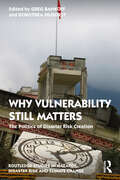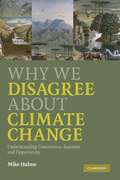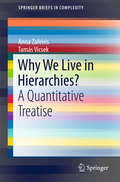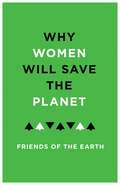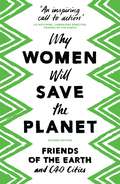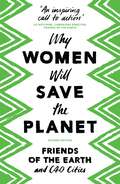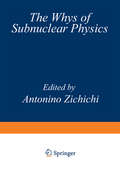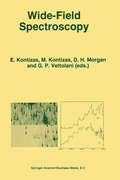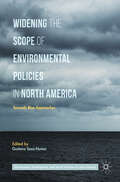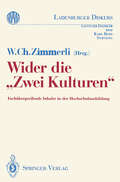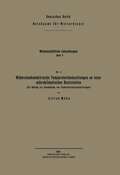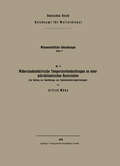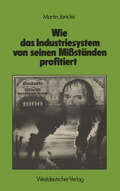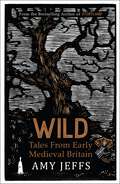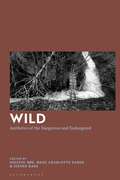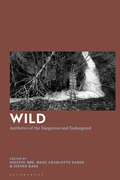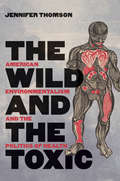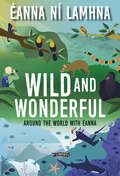- Table View
- List View
Why Vulnerability Still Matters: The Politics of Disaster Risk Creation (Routledge Studies in Hazards, Disaster Risk and Climate Change)
by Greg Bankoff Dorothea HilhorstWe think vulnerability still matters when considering how people are put at risk from hazards and this book shows why in a series of thematic chapters and case studies written by eminent disaster studies scholars that deal with the politics of disaster risk creation: precarity, conflict, and climate change. The chapters highlight different aspects of vulnerability and disaster risk creation, placing the stress rightly on what causes disasters and explaining the politics of how they are created through a combination of human interference with natural processes, the social production of vulnerability, and the neglect of response capacities. Importantly, too, the book provides a platform for many of those most prominently involved in launching disaster studies as a social discipline to reflect on developments over the past 50 years and to comment on current trends. The interdisciplinary and historical perspective that this book provides will appeal to scholars and practitioners at both the national and international level seeking to study, develop, and support effective social protection strategies to prevent or mitigate the effects of hazards on vulnerable populations. It will also prove an invaluable reference work for students and all those interested in the future safety of the world we live in.
Why We Disagree About Climate Change: Understanding Controversy, Inaction And Opportunity (PDF)
by Mike Hulme M. HulmeClimate change is not 'a problem' waiting for 'a solution'. It is an environmental, cultural and political phenomenon which is re-shaping the way we think about ourselves, our societies and humanity's place on Earth. Drawing upon twenty-five years of professional work as an international climate change scientist and public commentator, Mike Hulme provides a unique insider's account of the emergence of this phenomenon and the diverse ways in which it is understood. He uses different standpoints from science, economics, faith, psychology, communication, sociology, politics and development to explain why we disagree about climate change. In this way he shows that climate change, far from being simply an 'issue' or a 'threat', can act as a catalyst to revise our perception of our place in the world. Why We Disagree About Climate Change is an important contribution to the ongoing debate over climate change and its likely impact on our lives.
Why We Live in Hierarchies?: A Quantitative Treatise (SpringerBriefs in Complexity)
by Anna Zafeiris Tamás VicsekThis book systematically interprets and documents new, unifying principles and basic laws describing the most relevant aspects of hierarchy. To do so, it discusses recent experiments and models that are simple and realistic enough to reproduce the observations, and develops concepts for a better understanding of the complexity of systems consisting of many organisms. The book covers systems ranging from flocks of birds to groups of people. Although it focuses on hierarchical collective behavior in general, two aspects pop up in the majority of cases: collective motion and dynamically changing, partially directed networks (and the natural relation between the two). In addition, it offers a brief description of the most relevant definitions and concepts involved in the context of hierarchies, presenting both a review of the current literature and a number of new experimental and computational results in more detail. It is a valuable resource for students and scholars pursuing research on the structure of interactions within the collectives of animals and humans.
Why Women Will Save the Planet
by Bloomsbury PublishingCities across the globe are growing fast. Today many are environmental nightmares with polluted air, excessive energy consumption and an absence of nature. But big cities don't have to mean a dystopian future. They can be turned around to be powerhouses of well-being and environmental stability – if we empower women.This book is a unique collaboration between C40 and Friends of the Earth showcasing pioneering voices in the environmental and feminist movements. This book reveals just how women's empowerment is critical to environmental sustainability. This book is a rallying call – for the planet, for women, for everyone.
Why Women Will Save the Planet
by Bloomsbury PublishingBig cities don't have to mean a dystopian future. They can be turned around to be powerhouses of well-being and environmental sustainability – if we empower women.This book is a unique collaboration between C40 and Friends of the Earth showcasing pioneering city mayors, key voices in the environmental and feminist movements, and academics. The essays collectively demonstrate both the need for women's empowerment for climate action and the powerful change it can bring. A rallying call – for the planet, for women, for everyone.
Why Women Will Save the Planet
by Bloomsbury PublishingCities across the globe are growing fast. Today many are environmental nightmares with polluted air, excessive energy consumption and an absence of nature. But big cities don't have to mean a dystopian future. They can be turned around to be powerhouses of well-being and environmental stability – if we empower women.This book is a unique collaboration between C40 and Friends of the Earth showcasing pioneering voices in the environmental and feminist movements. This book reveals just how women's empowerment is critical to environmental sustainability. This book is a rallying call – for the planet, for women, for everyone.
Why Women Will Save the Planet
by Bloomsbury PublishingBig cities don't have to mean a dystopian future. They can be turned around to be powerhouses of well-being and environmental sustainability – if we empower women.This book is a unique collaboration between C40 and Friends of the Earth showcasing pioneering city mayors, key voices in the environmental and feminist movements, and academics. The essays collectively demonstrate both the need for women's empowerment for climate action and the powerful change it can bring. A rallying call – for the planet, for women, for everyone.
The Whys of Subnuclear Physics (The Subnuclear Series #15)
by Antonio L. ZichichiFrom 23 July to 10 August 1977 a group of 125 physicists from 72 laboratories of 20 countries met in Erice to attend the 15th Course of the International School of Subnuclear Physics. The countries represented at the School were: Belgium, Bulgaria, Denmark, Federal Republic of Germany, Finland, France, Hungary, Ireland, Israel, Italy, Japan, the Netherlands, Norway, Poland, Sweden, Switzerland, the United Kingdom, the United States of America and Venezuela. The School was sponsored by the Italian Ministry of Public Education (MPI), the Italian Ministry of Scientific and Technologi cal Research (MRST) , the North Atlantic Treaty Organization (NATO), the Regional Sicilian Government (ERS) and the Heizmann Institute of Science. The School was very exciting due to the impressive number of frontier problems which were discussed. Being the 15th year of the School, it was decided to review all outstanding "Whys". At various stages of my work I have enjoyed the collaboration of many friends whose contributions have been extremely important for the School and are highly appreciated. I would like to thank Dr.A. Gabriele, Ms.S. McGarry, Mr. and Mrs. S. Newman, Ms.P. Savalli and Ms.M. Zaini for the general scientific and administrative work. Finally, I would like to thank most warmly all those ~n Erice, Bologna and Geneva who helped me on so many occasions and to whom I feel very much indebted.
Wide-Field Spectroscopy: Proceedings of the 2nd Conference of the Working Group of IAU Commission 9 on “Wide-Field Imaging” held in Athens, Greece, May 20–25, 1996 (Astrophysics and Space Science Library #212)
by E. Kontizas M. Kontizas D. H. Morgan G. P. VettolaniE. KONTIZAS Astronomical Institute National Observatory of Athens P. O. Box 20048 Athens GR-1181O GREECE The international conference on "Wide-Field Spectroscopy" and its sub ject matter were agreed during the general assembly of the International Astronomical Union (IAU) in August 1994 by the Working Group of Com mision 9 "Wi de-Field Imaging". This meeting gave an opportunity to world experts on this subject to gather in Athens, in order to discuss the cur rent exploitation and the impending opportunities that exist in the area of multi-object spectroscopy, with particular emphasis on: 1. Astronomical instruments, data acquisition, processing and analysis techniques. 2. Astrophysical problems best tackled through wide-field, multi-object spectroscopy. The new fibre optic technology offers an important tool for the advancement of basic research and the development of industrial applications. Astronom ical spectroscopy is a field of astronomy which has contributed much to the advancement of fundamental physics. The spectra of hot stars have been used to determine the well-known Balmer formula for the wavelength of hydrogen lines, in the late 19th century. Since then, spectroscopy has made enormous progress in stellar atmosphere studies, in kinematics, and in the detection of high redshifts in the Universe. The traditional techniques of obtaining wide-field spectroscopic data are based on slitless spectroscopy (objective prism). Several observations, world wide, make use ofthese tech niques in order to obtain information on the spectral properties of objects in large areas of the sky.
Widening the Scope of Environmental Policies in North America: Towards Blue Approaches (Governance, Development, and Social Inclusion in Latin America)
by Gustavo Sosa-NunezThis edited volume provides a variety of insights into the context in which ocean and wetlands policy is placed at the sub-continental level. The governments of Mexico, Canada, and United States of America have recognized the importance of conserving, protecting, and enhancing the environment in their territories. As a result, they have developed an institutional structure aimed at furthering environmental cooperation. However, marine environment has played a secondary role, characterized by scientific cooperation that does not develop into regional policies. This project analyzes how ocean and wetlands preservation is omitted from the North American Agreement on Environmental Cooperation, meaning that collaborative efforts under-perform or remain largely sidelined from mainstream issues. As contributors come from a mix of the social and natural sciences (politics, international relations, law studies, sociology, oceanology, and oceanography), this book presents diverse viewpoints on how to address wetlands protection, deep ocean research collaboration, and the marine context of the Sustainable Development Goals.
Wider die „Zwei Kulturen“: Fachübergreifende Inhalte in der Hochschulausbildung (Ladenburger Diskurs)
by Walther C. Zimmerli0 d Den in diesem Band gesammelten Beiträgen geht es um konkrete Hinweise zur Überwindung der Kluft zwischen der naturwissenschaftlich-technischen und der geistig-sozialen Welt. Dabei wird an der universitären Ausbildung von Ingenieuren, Geistes- und Sozialwissenschaftlern angesetzt. Die Theoretische Grundannahme, daß ein neues "technologisches" Zeitalter heraufziehe, wird anhand einer fundamentalen Änderung in den Ausbildungsstrukturen von Hochschulen im deutschsprachigen Raum sichtbar gemacht. Dieses Buch zeichnet sich dadurch aus, daß es nicht kurzatmige Hochschulreformpläne vorstellt, sondern auf Erfahrungen beruhende Orientierung bietet.
Widerstandselektrische Temperaturbeobachtungen an einer mikroklimatischen Basisstation: Ein Beitrag zur Bearbeitung von Punktschreiberregistrierungen (Wissenschaftliche Abhandlungen)
by Alfred MädeDieser Buchtitel ist Teil des Digitalisierungsprojekts Springer Book Archives mit Publikationen, die seit den Anfängen des Verlags von 1842 erschienen sind. Der Verlag stellt mit diesem Archiv Quellen für die historische wie auch die disziplingeschichtliche Forschung zur Verfügung, die jeweils im historischen Kontext betrachtet werden müssen. Dieser Titel erschien in der Zeit vor 1945 und wird daher in seiner zeittypischen politisch-ideologischen Ausrichtung vom Verlag nicht beworben.
Widerstandselektrische Temperaturbeobachtungen an einer mikroklimatischen Basisstation (Wissenschaftliche Abhandlungen #5)
by Alfred MädeDieser Buchtitel ist Teil des Digitalisierungsprojekts Springer Book Archives mit Publikationen, die seit den Anfängen des Verlags von 1842 erschienen sind. Der Verlag stellt mit diesem Archiv Quellen für die historische wie auch die disziplingeschichtliche Forschung zur Verfügung, die jeweils im historischen Kontext betrachtet werden müssen. Dieser Titel erschien in der Zeit vor 1945 und wird daher in seiner zeittypischen politisch-ideologischen Ausrichtung vom Verlag nicht beworben.
Wideworld Volume 31 Issue 1 (PDF)
by Jane Ferretti Brian Greasley Malcolm RenwickGCSE Geography magazine
Wideworld Volume 31 Issue 2 (PDF)
by Jane Ferretti Brian Greasley Malcolm RenwickGCSE Geography magazine
Wideworld Volume 31 Issue 3 (PDF)
by Jane Ferretti Brian Greasley Malcolm RenwickGCSE Geography magazine
Wideworld Volume 31 Issue 4 (PDF)
by Jane Ferretti Brian Greasley Malcolm RenwickGCSE Geography magazine
Wie das Industriesystem von seinen Mißständen profitiert: Kosten und Nutzen technokratischer Symptombekämpfung: Umweltschutz, Gesundheitswesen, innere Sicherheit
by Martin JänickeWild: Tales from Early Medieval Britain
by Amy JeffsBy the bestselling author of Storyland.Sheer cliffs, salt spray, explosive sea spume, thunderous clouds, icy waves, whales with mountains on their backs, sleet, bitter winds, bleak, impenetrable marshes, howling wolves, forests, the unceasing cries of birds and the death grip of subterranean vaults that have never seen the sun: these are wild landscapes of a world almost familiar.In Wild, Amy Jeffs journeys - on foot and through medieval texts - from landscapes of desolation to hope, offering the reader an insight into a world at once distant and profoundly close to home. The seven chapters, entitled Earth, Ocean, Forest, Beast, Fen, Catastrophe, Paradise, open with fiction and close with reflection. They blend reflections of travels through fen, forest and cave, with retelling of medieval texts that offer rich depictions of the natural world. From the Old English elegies to the englynion and immrama of the Celtic world - stories that largely represent figures whose voices are not generally heard in the corpus of medieval literature: women, outcasts, animals.Illustrated with original wood engravings, evoking an atmospheric world of whales, wolves, caves, cuckoos and reeds, Wild: Tales From Early Medieval Britain will leave readers feeling 'westendream': delight in the wilderness.
Wild: Aesthetics of the Dangerous and Endangered
by Solveig Bøe, Hege Charlotte Faber and Eivind KasaIn this interdisciplinary work, philosophers from different specialisms connect with the notion of the wild today and interrogate how it is mediated through the culture of the Anthropocene. They make use of empirical material like specific artworks, films and other cultural works related to the term 'wild' to consider the aesthetic experience of nature, focusing on the untamed, the boundless, the unwieldy, or the unpredictable; in other words, aspects of nature that are mediated by culture. This book maps out the wide range of ways in which we experience the wildness of nature aesthetically, relating both to immediate experience as well as to experience mediated through cultural expression. A variety of subjects are relevant in this context, including aesthetics, art history, theology, human geography, film studies, and architecture. A theme that is pursued throughout the book is the wild in connection with ecology and its experience of nature as both a constructive and destructive force.
Wild: Aesthetics of the Dangerous and Endangered
In this interdisciplinary work, philosophers from different specialisms connect with the notion of the wild today and interrogate how it is mediated through the culture of the Anthropocene. They make use of empirical material like specific artworks, films and other cultural works related to the term 'wild' to consider the aesthetic experience of nature, focusing on the untamed, the boundless, the unwieldy, or the unpredictable; in other words, aspects of nature that are mediated by culture. This book maps out the wide range of ways in which we experience the wildness of nature aesthetically, relating both to immediate experience as well as to experience mediated through cultural expression. A variety of subjects are relevant in this context, including aesthetics, art history, theology, human geography, film studies, and architecture. A theme that is pursued throughout the book is the wild in connection with ecology and its experience of nature as both a constructive and destructive force.
The Wild and the Toxic: American Environmentalism and the Politics of Health
by Jennifer ThomsonHealth figures centrally in late twentieth-century environmental activism. There are many competing claims about the health of ecosystems, the health of the planet, and the health of humans, yet there is little agreement among the likes of D.C. lobbyists, grassroots organizers, eco-anarchist collectives, and science-based advocacy organizations about whose health matters most, or what health even means. In this book, Jennifer Thomson untangles the complex web of political, social, and intellectual developments that gave rise to the multiplicity of claims and concerns about environmental health. Thomson traces four strands of activism from the 1970s to the present: the environmental lobby, environmental justice groups, radical environmentalism and bioregionalism, and climate justice activism. By focusing on health, environmentalists were empowered to intervene in the rise of neoliberalism, the erosion of the regulatory state, and the decimation of mass-based progressive politics. Yet, as this book reveals, an individualist definition of health ultimately won out over more communal understandings. Considering this turn from collective solidarity toward individual health helps explain the near paralysis of collective action in the face of planetary disaster.
Wild and Wonderful: Around the World with Éanna
by Éanna Ní LamhnaGlow-in-the-dark owls, eggs boiling in Icelandic hot pools, the gangster tactics of the devil’s coach-horse beetle … Éanna Ní Lamhna has seen them all! Éanna explores the wonders of our wild world, from a safari in Tanzania to the cloud forests of Costa Rica, from rat-hunting in Canada to whale watching in New Zealand. She draws on her experience as a diver to tell of face-to-face encounters with fascinating fan worms, elusive sea hares and a murderous crab, and rings the alarm bells on the environmental challenges facing us. Éanna also recounts with cheerful relish the pitfalls and delights of being a broadcaster and a scientist. Sure why would anyone want to be anything else?
Wild by Design: The Rise of Ecological Restoration
by Laura J. MartinAn environmental historian delves into the history, science, and philosophy of a paradoxical pursuit: the century-old quest to design natural places and create wild species. Environmental restoration is a global pursuit and a major political concern. Governments, nonprofits, private corporations, and other institutions spend billions of dollars each year to remove invasive species, build wetlands, and reintroduce species driven from their habitats. But restoration has not always been so intensively practiced. It began as the pastime of a few wildflower enthusiasts and the first practitioners of the new scientific discipline of ecology. Restoration has been a touchstone of US environmentalism since the beginning of the twentieth century. Diverging from popular ideas about preservation, which romanticized nature as an Eden to be left untouched by human hands, and conservation, the managed use of natural resources, restoration emerged as a “third way.” Restorationists grappled with the deepest puzzles of human care for life on earth: How to intervene in nature for nature’s own sake? What are the natural baselines that humans should aim to restore? Is it possible to design nature without destroying wildness? Laura J. Martin shows how, over time, amateur and professional ecologists, interest groups, and government agencies coalesced around a mode of environmental management that sought to respect the world-making, and even the decision-making, of other species. At the same time, restoration science reshaped material environments in ways that powerfully influenced what we understand the wild to be. In Wild by Design, restoration’s past provides vital knowledge for climate change policy. But Martin also offers something more—a meditation on what it means to be wild and a call for ecological restoration that is socially just.
